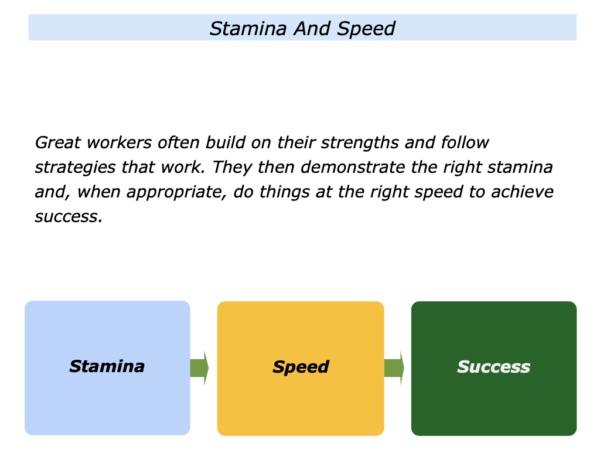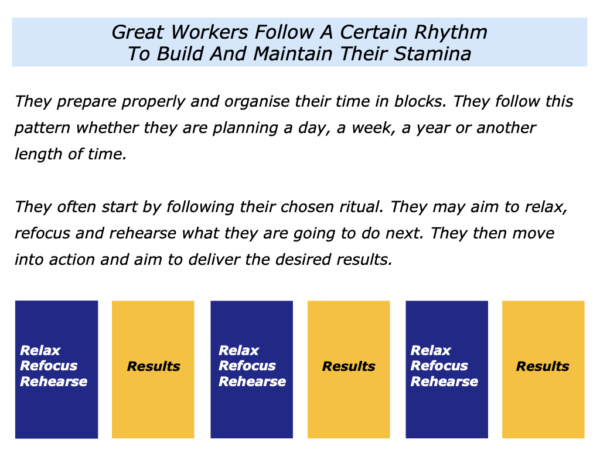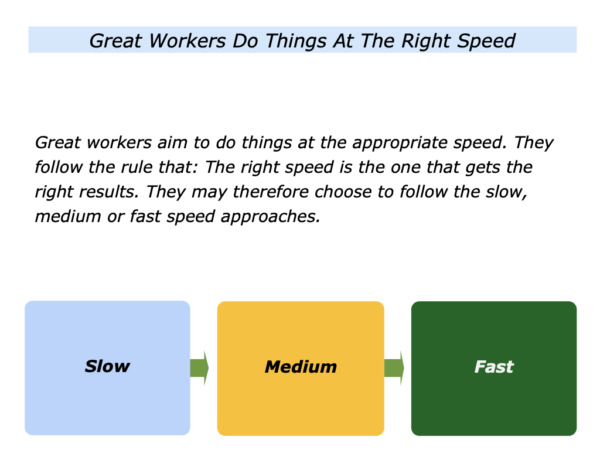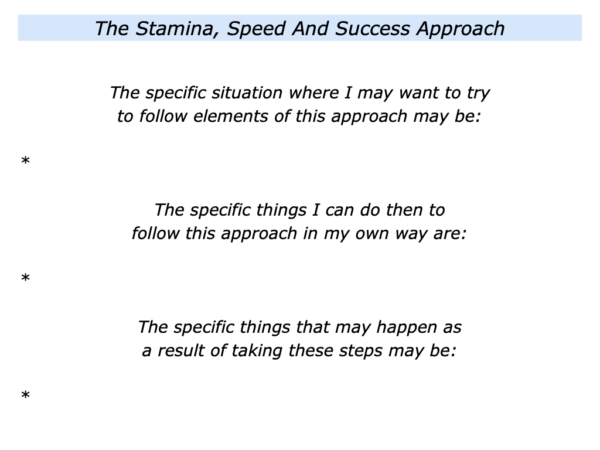
Great workers often build on their strengths and follow strategies that work. They then demonstrate the right stamina and, when appropriate, do things at the right speed to achieve success.
This piece focuses mainly on the stamina and speed aspects. But it is important to start by getting the basics right before moving into action. Let’s explore these themes.
Strengths
Great workers often build on their strengths. They focus on the specific activities where they deliver As rather than Bs or Cs. They aim to do what they do best and do their best.
Strategies That Work
Great workers focus on strategies that work. They sometimes do this by exploring the following themes.
What is the strength I want to build on? What is the piece of work I want to do by building on this strength? What are the real results I want to achieve? What is the picture of success? What will be the benefits of achieving these goals?
What are the strategies that work when aiming to achieve such goals? Bearing these in mind, What are the key strategies I can follow to give myself the greatest chance of success? How can I translate these into action? What will be happening that will show I have achieved the goals?
Such workers then move into action. This sometimes involves focusing on the following theme.
Stamina
Great workers develop the required stamina. They may do this when aiming to pursue their career, perform certain kinds of work or achieve the desired positive results.
Some workers demonstrate this stamina during careers and get better over the years. They may be pursuing a passion, following certain principles and aiming to achieve peak performance.
They may be working as artists, musicians, conductors or delivering other kinds of performances. They may be working as educators, therapists, mentors, trusted advisors or in other fields.
Such people who demonstrate such stamina are often following their vocation. Seeing each day as an opportunity to do their best, they believe in the philosophy that:
You never retire from your vocation.
Some people demonstrate the stamina to superb work over a short, medium or longer period. They may aim to write a book, run a marathon, lead a project, compete during a sporting season or do another activity over a period of time.
Different people maintain their stamina in different ways. Some start by getting the physical things right. They get the right food, the right amount of sleep and make sure they are fit to do the work. They then take the following steps.
They prepare properly. They plan ahead, organise their time and make sure all the practical things are in place. They also prepare themselves physically and psychologically.
They rehearse properly. They rehearse following their chosen strategies and managing any potential challenges along the way. They do this until they feel satisfied they have covered all eventualities.
They organise their time in blocks and make full use of their prime times – the times when they have most energy. They then follow their chosen rhythm for working.
They set achievable goals for a session, move into action and follow their chosen strategies. They do deep work, get some early successes and aim to do superb work.
They manage their energy properly. They continue working until they feel ready to break. They then take time to relax, revitalise themselves and rehearse what they are going to do next.
Great workers sometimes employ their second wind. This can be a physical or psychological second wind. It lead to getting a new burst of energy and going into new dimensions. They then do whatever is required to get over the line and achieve success.
Such workers often follow a certain routine. They map out their day, week, month or year and try to organise their time in blocks. This helps them to do good work and also regain their energy.

Imagine that a person has developed their stamina. Sometimes they may also focus on the next theme.
Speed
Great workers pace themselves properly. They pursue strategies that work and aim to do these at the right speed. Such an approach invites the question:
What is the right speed?
Great workers focus on the results in achieve in a situation. They then follow the rule that:
The right speed is the one that gets the right results.
Bearing this in mind, they may do things at what appears to be a slow, medium or fast pace. Let’s explore these different approaches.

The Slow Speed Approach
Great workers know when to do things in a relativity slow and measured way. They may do this when making key decisions. Going into a situation, they gather information and take the following steps:
They clarify what is actually happening, fix any immediate issues and clarify the real results to achieve – the picture of success;
They clarify the potential options going forward – together with the pluses and minuses of each option – and settle on their chosen option;
They clarify the key strategies they can follow to pursue their chosen option, create an action plan and do their best to achieve success.
Such workers often have knowledge bank that is based on making previous decisions. This may have been built slowly over time. But, when appropriate, they can access it and act quickly to make good decisions.
Some great workers may also have had a relatively slow start to their careers. They may have spent time following their passions before settling on a path they wanted to pursue.
They may then have absorbed themselves deeply in building up their knowledge. This created a firm base which they built on in future years. Such an approach is in contrast to people who may have been shooting stars early in their careers.
Different people go at different speeds when doing different tasks or at different stages of their careers. Sometimes they operate in the following way.
The Medium Speed Approach
Great workers sometimes follow the medium speed approach. They follow a rhythm where they do things in a measured but effective way. They aim to follow this routine and do fine work.
Some writers, craft workers and artists take this approach. They follow a consistent rhythm that enables them to follow good habits when doing their work. Sometimes this can also lead to flashes of inspiration where they then do things quickly.
Looking back, can you think of a time when you followed elements of this approach? You may have been studying for an exam, following an exercise programme, leading a project or doing another piece of work.
What was the routine you followed? How did you work at a consistent and effective way? When appropriate, how did you work more quickly? What happened as a result of taking these steps?
The Fast Speed Approach
Great workers sometimes do things at a fast pace. Some do this physically, some do it psychologically. Some do it in other ways – such as by using their strategic intuition to make creative breakthroughs.
Great footballers, for example, often do this simple things quickly – such as playing the simple pass. They are continually scanning the field to see patterns, picture and possibilities. They then use their strategic thinking and skills to execute the desired pass, shot or movement.
Such players know when to do the simple things well. They then, when appropriate, use their unique skills to do something special that helps their team to succeed.
Great workers follow a similar pattern in their chosen field. Sometimes they use what is called their strategic intuition. They are able:
To quickly see patterns, focus on the possible ways forward and clarify the desired picture of success;
To reach into their repertoire of experience, knowledge and tools to select and rehearse their chosen strategy for achieving success;
To apply their chosen strategy, keep reading reality and do what is required to achieve the picture of success.
Great workers may go into another dimension and move into their equivalent of the zone. They appear to do things slowly yet more swiftly than other people. Such workers then do something special to deliver the goods. This takes us to the next theme.
Success
Great workers aim to do things at the appropriate speed. They may do things at a slow, medium or fast pace. Sometimes they combine these elements to achieve success.
Such workers sometimes focus on the following steps. They aim: a) to build a solid base; b) to do superb work; c) to use their strategic intuition to do something special to deliver success.
William Duggan, author of the book Strategic Intuition, has described how such intuition works. He explained this in the following way.
Flashes of insight are so important that scholars have written about them for centuries. The best description comes from an early classic of military strategy, On War by Carl von Clausewitz.
Clausewitz gives us four steps.
First, you take in ‘examples from history’ throughout your life and put them on the shelves of your brain. Study can help, by putting more there.
Second comes ‘presence of mind,’ where you free your brain of all preconceptions about what problem you’re solving and what solution might work.
Third comes the flash of insight itself. Clausewitz called it coup d’oeil, which is French for ‘glance.’
In a flash, a new combination of examples from history fly off the shelves of your brain and connect.
Fourth comes ‘resolution,’ or determination, where you not only say to yourself, “I see!”, but also, “I’ll do it!”
There are many ways to do fine work. Great workers sometimes aim to build on their strengths and follow strategies that work. They then demonstrate the right stamina and speed to deliver success.
Looking ahead, can you think of situation where you may want to follow elements of this approach? How can you follow it in your own way? What may happen as a result of taking these steps?
If you wish. Try tackling the exercise on this theme. This invites you to complete the following sentences.







Leave a Reply